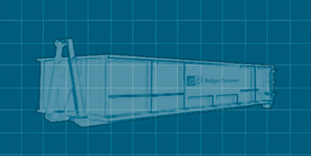
How to Calculate Cubic Yards
Learn what a cubic yard is and how to measure one with this simple guide.

What Is a Cubic Yard?
A cubic yard is a unit of volume equivalent to a cube with a length, width and height of 1 yard (or 3 feet).
To get an idea of how big a cubic yard is, a standard washing machine is about the size of 1 cubic yard.
Dumpsters are similar in shape to long cubes, so we calculate their volume in cubic yards and refer to them based on how many cubic yards of debris they can hold. A 10 yard dumpster holds 10 cubic yards, a 30 yard dumpster holds 30, and so on. Knowing how to calculate cubic yards helps you assess your debris so you can choose the right container size for your project.
How do I measure a cubic yard?
To measure a cubic yard, start by measuring the area your debris covers in feet. To do that, find the length and width of your debris and multiply the two numbers. Then multiply that value by the height of the stacked materials, divide the answer by 27 and you’ll have your cubic yardage. For more details on each step, reference the sections below.
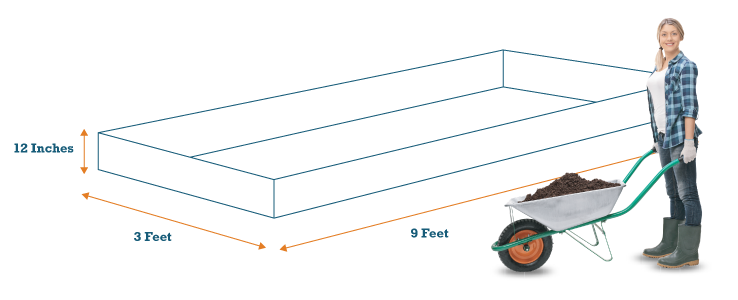
Measure the Area
First, measure the area in feet. To convert inches to feet, divide the number of inches by 12. Measure the length, width and height (or depth) of your debris. Use a tape measure or a measuring wheel for larger areas.
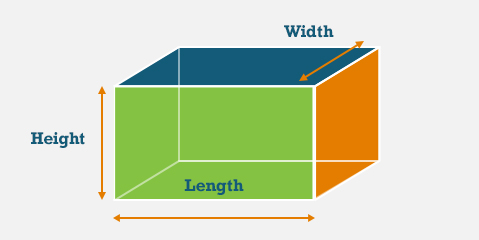
Calculate the Volume
Next, multiply the length, width and height measurements. Divide this number by 27. This will give you the volume in cubic yards. For how to calculate cubic yards using the graphic above as an example, the steps would be:
- First, convert inches to feet: 12 inches ÷ 12 = 1 foot
- Then, multiply length x width x height: 9 x 3 x 1 = 27
- Divide the answer by 27: 27 ÷ 27 = 1 cubic yard
You can also easily calculate cubic yardage by converting all three dimensions of your material into yards and multiplying them. For example, if you dig up a flower bed that is 9 feet long, 3 feet wide and 12 inches deep, you will have one cubic yard of dirt. This is how it breaks down:
- 3 feet equals 1 yard, so 9 feet equals 3 total yards in length.
- The width of 3 feet equals 1 yard.
- The height/depth is 12 inches (1 foot), which equals one-third of a yard.
Multiplying the three dimensions — length, width and height/depth — gives you the total cubic yardage of your debris. In this example, 3 yards x 1 yard x 1/3 yard = 1 cubic yard of dirt.
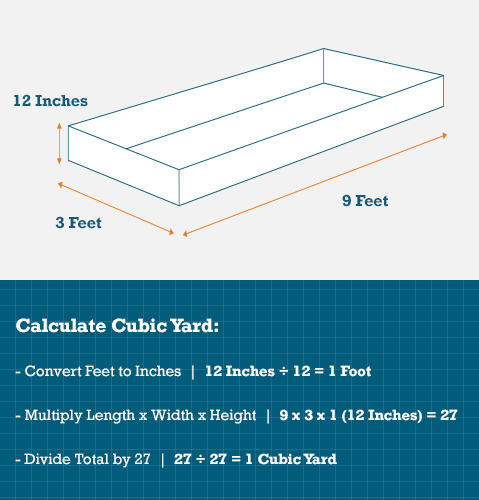
How Big Is a Cubic Yard?
Once you’ve figured out how to measure cubic yards, it may still be difficult to envision how much a cubic yard is. It can be helpful to imagine the volume of a typical washing machine, which is equal to about 1 cubic yard. You can also picture cubic yards as wheelbarrow loads, trash bags or pickup truck loads.
Dumpsters with varying dimensions can hold the same amount of volume. Some may be long, some may be tall and some may be short — but they may all hold the same number of cubic yards.
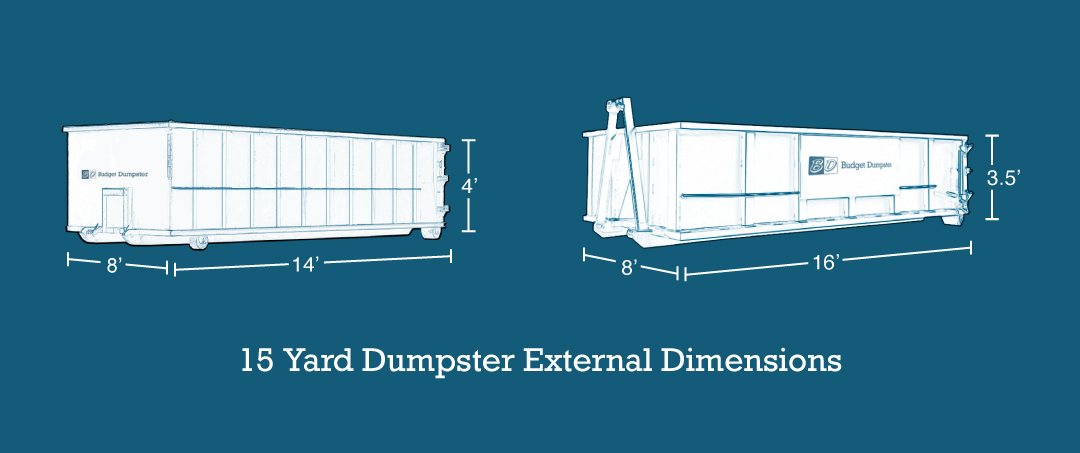
Here's how our most common dumpster sizes break down:
Dumpster Size | 33-Gallon Trash Bags | Wheelbarrow Loads | Pickup Truck Loads |
|---|---|---|---|
50 to 70 | 80 to 100 | 3 | |
65 to 85 | 98 to 118 | 3 - 4 | |
80 to 100 | 125 to 145 | 4 - 5 | |
110 to 130 | 170 to 190 | 6 | |
170 to 190 | 260 to 280 | 9 | |
230 to 250 | 350 to 370 | 12 |
How many cubic feet are in a cubic yard?
There are 27 cubic feet in 1 cubic yard.
How many square feet are in a cubic yard?
When you spread out a cubic yard of material like dirt or mulch, it will cover 324 square feet at a depth of 1 inch. If you spread it at a depth of 3 inches, you will only cover 108 square feet. This comparison can be helpful as you take stock of your debris and visualize how it will fit into your dumpster.
How Much a Cubic Yard Weighs by Debris Type
Besides volume, the weight of your debris is an important factor in choosing the right dumpster size. Each dumpster has a set weight limit, which is different from its volume capacity. Cubic yards are a measure of volume, not a measure of weight.
So, depending on what you’re throwing away, two full 10 cubic yard dumpsters could have significantly different weights. Our weight calculators are helpful for determining the weight of your specific debris types. Here are the approximate weights of 1 cubic yard of common materials.
1 Cubic Yard of Material | Weight in Pounds |
|---|---|
Household debris | 150 to 300 |
Scrap wood | 300 |
Drywall | 500 |
Mulch | 600 to 1,000, depending on moisture content |
Scrap metal | 1,000 |
Soil | 2,000 |
Carpet | 2,300 to 3,200 |
Sand | 2,700 |
Gravel or Rock | 3,000 |
Concrete | 4,000 |
Asphalt | 4,000 |
How to Choose the Right Size Dumpster for Your Debris
Now that you know the answer to “What is a cubic yard?,” choosing the right size dumpster is a breeze. Consider both the volume and weight of your materials, as well as the typical dumpster dimensions that follow:
10 cubic yard dumpster — 14' long x 7.5' wide x 3.5' high
12 cubic yard dumpster — 14’ long x 7.5’ wide x 4’ high
15 cubic yard dumpster — 16’ long x 7.5’ wide x 4.5’ tall
20 cubic yard dumpster — 22' long x 7.5' wide x 4.5' high
30 cubic yard dumpster — 22' long x 7.5' wide x 6' high
40 cubic yard dumpster — 22' long x 7.5' wide x 8' high
Getting rid of furniture, household junk or other items not covered here?

Our roll off dumpster size chart has even more information to help you compare dumpster sizes, visualize how much they hold and choose the right size bin for your project.
Frequently Asked Questions
How do I convert square feet to cubic yards?
To convert square feet into cubic yards, you’ll need to find two measurements. If you’re calculating the amount of debris on your driveway, for example, you’ll first need to know the square footage of the area covered by debris. Then measure how high you stacked the debris to find your depth. Plug those values into the formula below and you’ll find your cubic yardage:
Cubic yards = (square feet x depth in feet) / 27
What’s the difference between a yard and a cubic yard?
A yard measures a two-dimensional area while a cubic yard measures three-dimensional volume, or how much a space can hold.
How many cubic yards can you fit in a pickup truck?
A standard full-size pickup truck can hold about 2 to 3 cubic yards, depending on material.
How many cubic yards can you fit in a wheelbarrow?
A typical wheelbarrow holds 2 to 3 cubic feet, depending on its size. This means you can fit about 1/14 to 1/9 of a cubic yard in a wheelbarrow.
How much does a cubic yard of dirt weigh?
Dirt varies in weight depending on its moisture content. One cubic yard of dirt weighs about 2,000 pounds dry, while that same amount of dirt weighs around 3,000 pounds when wet.
How much does a cubic yard of concrete weigh?
A solid cubic yard of concrete typically weighs about 4,000 pounds, depending on the mix design, moisture content and materials used. When broken up, the concrete itself doesn’t lose weight, but the volume it takes up increases due to air gaps between pieces. As a result, a cubic yard of container space filled with broken concrete usually holds 2,000 to 3,000 pounds of material. Use our weight calculators to determine how heavy your concrete is.
